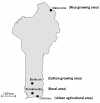Dynamics of insecticide resistance in malaria vectors in Benin: first evidence of the presence of L1014S kdr mutation in Anopheles gambiae from West Africa
- PMID: 21910856
- PMCID: PMC3179749
- DOI: 10.1186/1475-2875-10-261
Dynamics of insecticide resistance in malaria vectors in Benin: first evidence of the presence of L1014S kdr mutation in Anopheles gambiae from West Africa
Abstract
Background: Insecticide resistance monitoring is essential to help national programmers to implement more effective and sustainable malaria control strategies in endemic countries. This study reported the spatial and seasonal variations of insecticide resistance in malaria vectors in Benin, West Africa.
Methods: Anopheles gambiae s.l populations were collected from October 2008 to June 2010 in four sites selected on the basis of different use of insecticides and environment. WHO susceptibility tests were carried out to detect resistance to DDT, fenitrothion, bendiocarb, permethrin and deltamethrin. The synergist piperonyl butoxide was used to assess the role of non-target site mechanisms in pyrethroid resistance. Anopheles gambiae mosquitoes were identified to species and to molecular M and S forms using PCR techniques. Molecular and biochemical assays were carried out to determine kdr and Ace.1R allelic frequencies and activity of the detoxification enzymes.
Results: Throughout the surveys very high levels of mortality to bendiocarb and fenitrothion were observed in An. gambiae s.l. populations. However, high frequencies of resistance to DDT and pyrethroids were seen in both M and S form of An. gambiae s.s. and Anopheles arabiensis. PBO increased the toxicity of permethrin and restored almost full susceptibility to deltamethrin. Anopheles gambiae s.l. mosquitoes from Cotonou and Malanville showed higher oxidase activity compared to the Kisumu susceptible strain in 2009, whereas the esterase activity was higher in the mosquitoes from Bohicon in both 2008 and 2009. A high frequency of 1014F kdr allele was initially showed in An. gambiae from Cotonou and Tori-Bossito whereas it increased in mosquitoes from Bohicon and Malanville during the second year. For the first time the L1014S kdr mutation was found in An. arabiensis in Benin. The ace.1R mutation was almost absent in An. gambiae s.l.
Conclusion: Pyrethroid and DDT resistance is widespread in malaria vector in Benin and both metabolic and target site resistance are implicated. Resistance was not correlated with a change of malaria species and/or molecular forms. The 1014S kdr allele was first identified in wild population of An. arabiensis hence confirming the expansion of pyrethroid resistance alleles in Africa.
Figures





References
-
- WHO. World Malaria Report 2010. World Health Organization, Geneva;
-
- Djogbenou L, Dabire R, Diabate A, Kengne P, Akogbeto M, Hougard JM, Chandre F. Identification and geographic distribution of the ACE-1R mutation in the malaria vector Anopheles gambiae in south-western Burkina Faso, West Africa. Am J Trop Med Hyg. 2008;78:298–302. - PubMed
-
- Diabate A, Brengues C, Baldet T, Dabire KR, Hougard JM, Akogbeto M, Kengne P, Simard F, Guillet P, Hemingway J, Chandre F. The spread of the Leu-Phe kdr mutation through Anopheles gambiae complex in Burkina Faso: genetic introgression and de novo phenomena. Trop Med Int Health. 2004;9:1267–1273. doi: 10.1111/j.1365-3156.2004.01336.x. - DOI - PubMed
Publication types
MeSH terms
Substances
LinkOut - more resources
Full Text Sources
Miscellaneous

